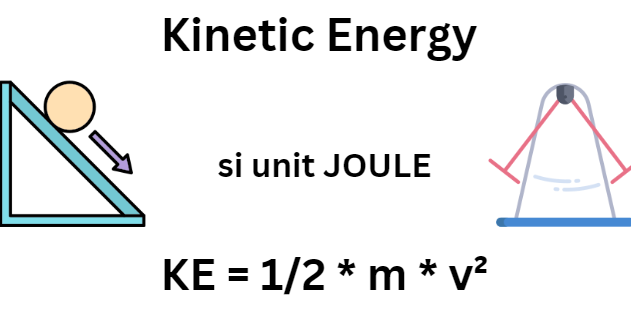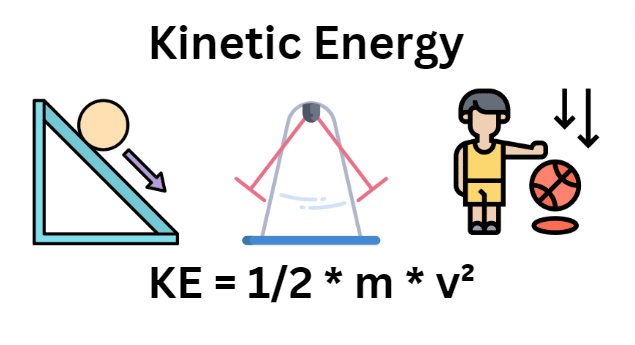Kinetic energy is a fundamental concept in physics that describes the energy of an object due to its motion. Derived from the Greek word “kinesis” meaning “motion”, kinetic energy refers to an object’s energy when it is in motion and depends on its mass and speed.SI unit of kinetic energy is given bellow after some
KINETIC ENERGY DETAILED EXPLAIN
The mathematical equation for kinetic energy is:
KE = 1/2 * m * v²
Where:
KE represents kinetic energy,
m represents the mass of the object, and
v represents the velocity (speed) of the object.
Kinetic energy is a form of energy that an object possesses due to its motion. When an object is in motion, it has the ability to do work or transfer energy to other objects. The amount of kinetic energy an object possesses depends on its mass and velocity.
According to this equation, the kinetic energy of an object is directly proportional to its mass and increases exponentially with the square of its velocity. This means that doubling the mass of an object will double its kinetic energy while doubling the velocity will increase the kinetic energy four times.
For example, a car moving at a higher speed will have more kinetic energy than the same car moving at a lower speed, assuming its masses are the same. Similarly, a heavier object moving at the same velocity as a lighter object will have more kinetic energy.
Note: Overall, kinetic energy is the energy of motion possessed by an object, determined by its mass and velocity. It is a fundamental concept in physics and plays a significant role in understanding and analyzing the physical world.

What Is The Si Unit Of Kinetic Energy?
The SI unit of kinetic energy is the joule (J). The joule is a derived unit in the International System of Units (SI) and is defined as the amount of energy transferred when a force of one newton acts on an object to move it one meter in the direction of the force. Since kinetic energy is a form of energy, it is measured in the same unit, the joule.
Derivation Of SI Unit Of Kinetic Energy?
The SI unit of kinetic energy, the joule (J), can be derived from the basic SI units for mass, length, and time.
In the SI system, the unit for mass is the kilogram (kg), the unit for length is the meter (m), and the unit for time is the second (s).
To derive the unit of kinetic energy, we consider the equation for kinetic energy:
KE = 1/2 * m * v^2
Where:
KE represents kinetic energy,
m represents mass, and
v represents the velocity.
The SI unit for mass, the kilogram (kg), is already in the equation. Now we need to derive the SI units for velocity and square velocity.
Velocity is defined as the change in position over time. It is calculated by dividing the length travelled by the time taken. Therefore, the SI unit for velocity is meters per second (m/s).
When we square the velocity to calculate v^2, the units are squared as well, resulting in (m/s)^2.
Now, combining the units, we have:
KE = 1/2 * (kg) * (m/s)^2
Expanding the equation:
KE = 1/2 * kg * m^2/s^2
Since the kilogram (kg) is equivalent to (kg * m^2/s^2), we can simplify the equation:
KE = 1/2 * kg * m^2/s^2
The term kg * m^2/s^2 is defined as the joule (J), which is the SI unit of energy.
Therefore, the SI unit of kinetic energy (KE) is the joule (J), derived from the SI units of mass (kg), length (m), and time (s).
